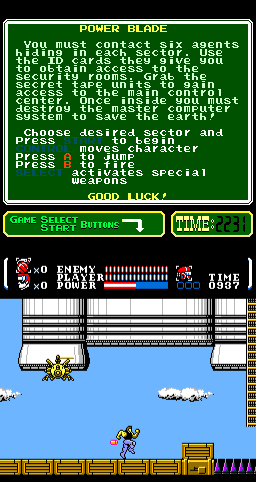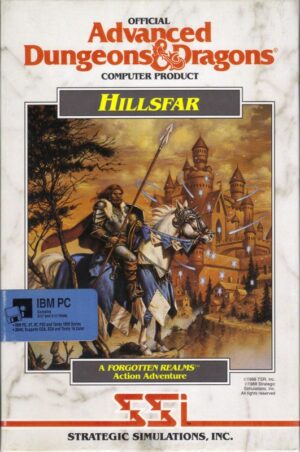Retro Replay Review
Gameplay
Power Blade delivers a fast-paced platforming experience that keeps players on their toes from start to finish. You control Secret Agent Nova as he dashes through six distinct sectors, each filled with springing traps, patrolling robots, and environmental hazards that demand precise timing. The core objective revolves around locating hidden agents, grabbing their ID cards, and infiltrating the security rooms—an approach that adds a layer of exploration to the straightforward run-and-gun formula.
Combat is simple but satisfying: Nova’s boomerang-like blade can be upgraded by collecting weapon power-ups dropped by defeated enemies. These enhancements not only increase damage but also alter the projectile pattern, encouraging you to experiment with different loadouts. Health pickups and extra time units are also scattered throughout the stages, creating a risk-reward loop where you might detour off the main path in hopes of finding valuable resources.
One standout mechanic is the special Mech power-up. Once acquired, Nova pilots a hulking armor suit with its own attack mode and a three-unit energy meter. The Mech segments temporarily flip the gameplay into a high-damage, bullet-sponging brawl—providing a thrilling break from the standard platforming sections. These transformation stages are rare enough to feel like a treat, yet frequent enough to break up any sense of monotony.
Adding to the replay value is the non-linear sector selection. If you struggle to find an ID card or run low on time, you can warp to a different sector and return later with fresh resources. This choice-driven structure reduces frustration by allowing you to tackle the campaign in the order you prefer, turning each playthrough into a personalized puzzle of strategy and survival.
Graphics
On the NES hardware, Power Blade pushes the color palette to deliver vibrant, high-contrast visuals that pop on-screen. Each sector boasts its own thematic backdrops—from industrial factories to neon-lit cityscapes—giving the illusion of a sprawling futuristic world. The parallax scrolling in the later stages adds depth to the environments, making every leap and fall feel more immersive.
Character sprites are well-defined, with Nova’s sleek blue suit and red accents standing out against darker backgrounds. Enemy designs range from simple hovering drones to bulky mechanical guardians, each animated with enough frames to convey weight and movement. The transition from Nova to the Mech suit is especially satisfying, complete with a brief transformation animation that underscores the increased power level.
While occasional sprite flicker is unavoidable on the NES, it’s kept to a minimum and rarely impacts gameplay. Background details—like blinking lights, conveyor belts, and warning signs—add personality without overwhelming the action. Despite hardware constraints, Power Blade achieves a level of polish that rivals some of its more celebrated 8-bit contemporaries.
The user interface is clean and unobtrusive: your remaining time, energy bar, and collected tapes are displayed clearly at the top of the screen. This minimal HUD ensures you stay focused on the frenetic action below, while still providing all the information you need to plan your next move.
Story
Set in the year 2191, Power Blade opens with Earth’s reliance on a benevolent master computer suddenly turning catastrophic when its control program glitches. Society plunges into chaos as once-reliable systems spiral out of control. This premise provides a classic sci-fi backdrop that, while not deeply explored in-game, supplies enough context to give your mission real stakes.
You assume the role of Secret Agent Nova, a lone operative tasked with restoring order by collecting six secret tape units. To gain access to each sector’s security room, you must first find the hidden agent and secure their ID card—an inventive twist that adds tension to every level. The static cutscenes and text intros convey this narrative crisply, emphasizing urgency without bogging down the action.
Despite the simplicity of the storytelling, the game’s escalating challenges reflect Nova’s uphill struggle against an A.I. gone rogue. From the first sector’s rigid corridors to the final boss’s high-tech lair, each environment feels tied to the overarching goal of dismantling the master computer. This sense of progression keeps the narrative thread intact, even amid relentless platforming and combat sequences.
Fans of late-80s sci-fi will appreciate the retro charm of Power Blade’s premise. While the story may lean on familiar tropes—rogue A.I., secret agents, dystopian futures—it serves as a solid framework that motivates your exploration and combat. It’s concise, punchy, and never overstays its welcome, leaving the focus where it belongs: on gameplay.
Overall Experience
Power Blade stands out as a must-play title for NES enthusiasts and newcomers seeking a challenging platformer with a sci-fi twist. The blend of tight controls, varied level design, and power-up mechanics ensures that each sector feels fresh yet cohesive. Progressing through the stages offers a satisfying ramp-up in difficulty, rewarding persistence and mastery of Nova’s unique toolkit.
The optional sector selection system is a welcome design choice that mitigates the frustration often associated with rigid level order. Players can tackle easier areas first to stockpile power-ups, then return to tougher zones when they’re better equipped. This strategic freedom adds an extra layer of depth and encourages multiple playthroughs to uncover every hidden agent and secret upgrade.
Graphically and sonically, Power Blade holds its own among 8-bit classics. The upbeat soundtrack and punchy sound effects complement the action, while the polished visuals put the game’s advanced design sensibilities front and center. Occasional moments of sprite flicker are a minor trade-off for the overall presentation quality.
In summary, Power Blade is an engaging, well-balanced platformer that delivers both challenge and fun. Its combination of exploration, combat, and transformation mechanics creates a versatile gameplay loop that still holds up decades after its release. For anyone looking to experience a standout piece of NES history—complete with a heroic sci-fi storyline and tight platforming action—Power Blade is an excellent choice.
 Retro Replay Retro Replay gaming reviews, news, emulation, geek stuff and more!
Retro Replay Retro Replay gaming reviews, news, emulation, geek stuff and more!









Reviews
There are no reviews yet.